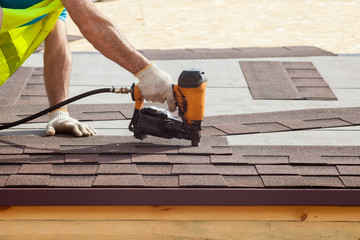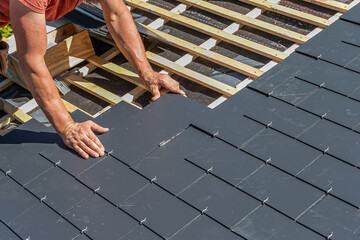A roof is constantly exposed to the elements and will naturally wear out over time. Depending on the extent of damage, repairs or a new roof might be the best option.
If you have neighbors, consider letting them know about your roof replacement ahead of time. This way, they can prepare by trimming trees and moving outdoor objects. Visit https://www.corpuschristiroofcompany.com/ to learn more.
A roof is a fundamental component of any home. Although maintenance and repairs can extend the life of a roof, at some point, it will need to be replaced in order to protect the house and prevent damage and safety hazards. Replacing a roof can be a big expense, but it’s an investment that can improve the safety and value of a home.
There are many factors that affect the cost of a roof replacement, some of which are outside the homeowner’s control, such as geographic location and weather conditions. However, the choice of shingles and other roofing materials is an area that can make a huge difference in the cost of the project. Premium materials may be more expensive, but they can last longer and add value to the home.
The extent of the damage is another factor that can determine whether repairs or replacement are necessary. Minor issues, like leaks or missing shingles, can be addressed with minor repairs, which are much less expensive than a full replacement. But major problems can lead to structural damage, which may require a full replacement, which is significantly more expensive.
Homeowners can also save money on a roof replacement by taking advantage of available tax credits and deductions. While tax deductions lower a taxpayer’s taxable income, tax credits reduce the amount of taxes owed dollar-for-dollar. For example, homeowners who install energy-reducing materials on their roof can receive a credit of up to 10% of the total costs of the new roof.
If a homeowner chooses to finance a roof replacement with a personal loan, they should pay attention to the terms and interest rates to ensure that they can afford to repay the loan. Failing to pay back a personal loan can have serious consequences for the borrower’s credit score.
Some homeowners may also be able to use the proceeds from the sale of their home to cover the cost of a roof replacement. This is a good option for those who plan on selling their home soon, as it will allow them to deduct the cost of the new roof from their sales price.
Materials
The roofing material used in a roof replacement is one of the biggest factors that can affect the cost. This is a choice that homeowners can control, and it can also impact the longevity of the roof and add to the value of the home. Splurging on a luxury material can be worthwhile for some, while others may want to save money by choosing an inexpensive option.
There are many different roofing materials to choose from, including shingles and tiles. Each has its own benefits and drawbacks. Asphalt shingles are cost-effective and come in a variety of colors, while wood shakes offer a classic aesthetic that lasts up to 60 years. Metal roofs are a more durable and energy-efficient option, but they can be expensive.
Some manufacturers produce impact-resistant roofing materials, which could be a good option for homeowners in hail-prone areas. There are also flat roof membranes that are highly durable and resistant to UV rays.
Other common options include concrete and clay tiles. These are often more expensive than shingle types, but they provide long-term durability and reduced cooling costs.
If you opt for tile, ask about installation and maintenance. It is best to leave this type of roof to a professional as it can be more difficult to install than other roofing materials. The lifespan of a tile roof is up to 50 years, but it is vulnerable to moss and insect damage.
Another item to consider is whether the contractor offers a warranty on their work. There are generally two types of warranties: a workmanship warranty and a materials warranty. The contractor’s warranty usually covers any issues caused by the work, while the manufacturer’s service contract covers the quality of the products.
Before making a decision, you should ask the roofing company about their warranty policies. Many companies will provide a transferable workmanship warranty for up to 30 years. This is important because if you decide to sell your home in the future, you will need to be sure the roof is under warranty.
Installation
Your roof is your home’s first line of defense against the elements. Over time, wear and tear can lead to leaks and damage, which is why it’s important to regularly inspect your roof for any issues. If you find any problems, it’s best to hire a professional roofing contractor to replace the damaged areas. This will help protect the integrity of your home and ensure that you’re getting the most out of your new roof.
Before a roof replacement project starts, it’s essential to make sure that you have all the necessary permits and inspections in place. This step will allow a city inspector to visit your property and verify that the work meets all local codes. Additionally, a permit will provide you with proof that the work has been completed correctly, which is essential for insurance claims and future resale.
The first thing a roofing contractor will do before starting the job is assess the existing roof to determine its condition and identify any underlying issues that need repair. This step is important because it can help you decide what type of materials to use for your new roof. For example, some materials are better suited for certain climates and may not be appropriate for your area. A qualified roofing contractor can help you choose the right material for your needs and budget.
During the installation process, your roofing contractor will start by clearing the area around the roof and gutters. They will then remove the old shingles and any debris. They’ll also check the underlying structure for areas that need repair, such as rotted boards or flashing. They will also install underlayment, which is a layer of water-resistant material that protects the underlying sheathing. This is particularly important in South Florida, where moisture can cause severe damage to the underlying wood.
Once the underlayment is in place, your roofing contractor will start installing the shingles. They’ll begin with the eaves, and then move to the valleys and roof edges. They’ll also install any needed flashing around chimneys, skylights, stack vents, and other areas that are prone to leaks. Lastly, they’ll install ridge vents to improve attic ventilation and reduce energy costs.
Warranty
The warranty offered by the manufacturer is a key consideration in your roof replacement project. It should be comprehensive, lasting for many years and covering the entire cost of a new roof. It should also be transferable if you decide to sell your home in the future.
A reliable roofing warranty will have non-prorated periods of 25 years or more for materials and a decade or more for workmanship. These extended periods will give homeowners peace of mind and a sense of security against future repairs or replacement costs. These warranties will help you to avoid costly repairs over time, and they will also enhance your home’s market value.
There are three primary types of roof warranties: standard material warranties, extended material warranties and workmanship warranties. Standard material warranties protect the homeowner from defects in the roofing materials themselves and typically cover the cost of a full roof replacement (excluding easy-to-replace auxiliary roof components). Extended material warranties provide additional protection by extending the original manufacturer’s warranty for a longer period. And, workmanship warranties provide protection against installation errors and faulty repairs.
Unfortunately, not all manufacturers offer extended warranty plans, and those that do will typically require you to work with only certified contractors and use specific roofing materials to qualify. In addition, you must engage in regular inspections to maintain your coverage. The more often you have your roof inspected by a professional, the less likely you are to be denied a claim due to a warranty violation.
Do Roof Repair Warranties Cover Hail Damage?
Depending on the roofing materials you choose and your location, it may be wise to purchase a warranty that covers hail damage. Some roofing materials are designed to withstand impact from damaging hail, and some even come with a lifetime manufacturer’s warranty against this type of damage.
Purchasing a new roof is one of the largest investments that most homeowners will ever make in their homes. But, many are unaware of the important details that need to be addressed to ensure a solid investment and a worry-free roofing system. By taking the time to understand the finer points of a roofing warranty, you can be sure that your new roof is fully protected.


